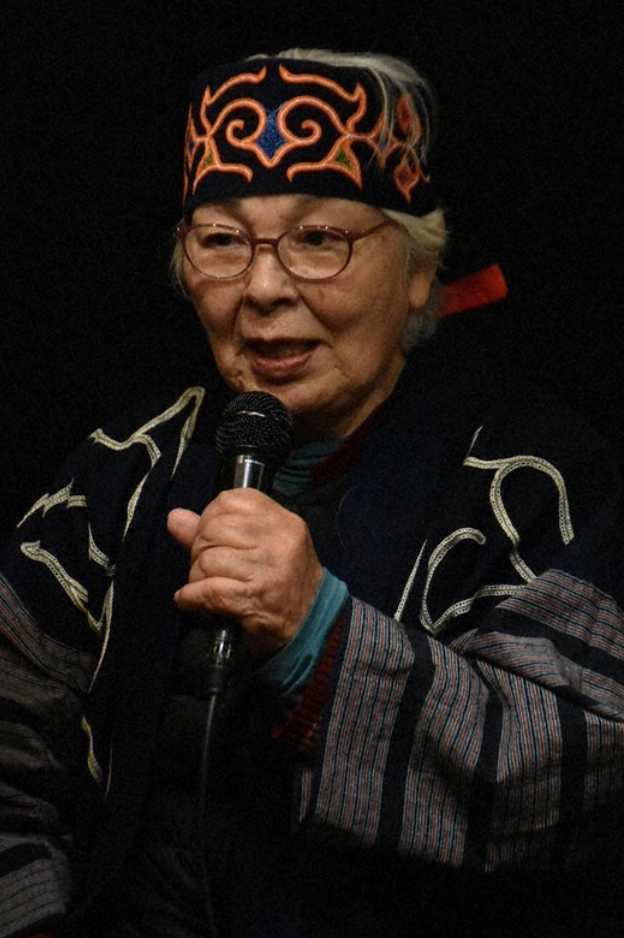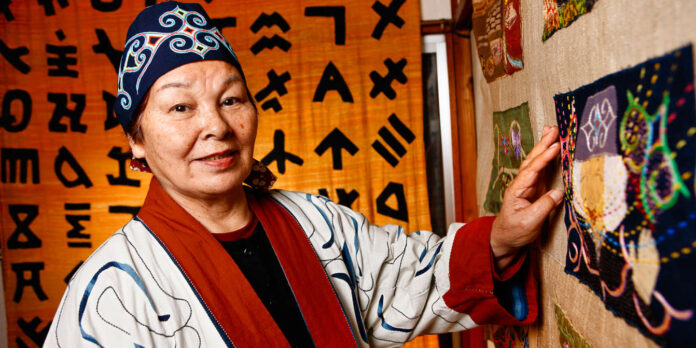Shizue Ukaji (宇梶 静江, Ukaji Shizue), born March 13, 1933 in
Urakawa, Hokkaido is an Ainu activist, artist and poet.
His origins
Ukaji and his brothers grew up with little money, skipped school, and
they got part-time jobs to help support the family.
When he was 20 years old, he moved to Sapporo to go to high school. He will
He moved to Tokyo when he was 23, hoping there would be less discrimination against the Ainu there than there was in his birthplace. There he dedicated himself to spreading traditional Ainu culture and fighting against prejudice and discrimination.

She worked as a waitress and furthered her education by listening to passing college students and reading what they read. She subsequently married and had a son with Takashi Ukaji.
Trajectory
Ukaji was introduced to the activism of the movement for the rights of
indigenous Ainu people during the 1970s. In 1975, he asked Mayor Ryokichi Minobe
to conduct a survey on the socioeconomic conditions of the ethnic group in Tokyo. The survey revealed that there were about 600 Ainu households in
Tokyo, and that many depended on manual labor. Thus, the position of counselor was created
Ainu at the Shinjuku Metropolitan Bureau of Economic Security, for
that community members could receive help in finding employment. Ukaji held this position for a few months, but stopped due to heavy workload.
Ukaji dedicated himself to spreading traditional Ainu culture and fighting prejudice and discrimination
During the ’90s, she began to study embroidery. In 1996, she returned to Hokkaido to further his knowledge of traditional Ainu designs and incorporate it into his previous studies. His work enjoys great prestige not only in Japan but also abroad and typically focuses on Ainu legends, stitched into the kimono fabric as if it were a tapestry. He has also published children’s books based on his tapestries.

In 2004, Ukaji received the Ainu Culture Promotion Award. In 2006 she helped produce a film called “Tokyo Ainu” about the Ainu living in Tokyo and the prejudice they suffer when they share their origins.
Ukaji won the Eiji Yoshikawa Cultural Award in 2011 and the 8th Ainu Cultural Promotion Award.
Present
While engaged in cultural dissemination activities as a member of the Kanto Utari Association, she gives lectures and conducts cultural dissemination activities in administrative and educational institutions throughout the country as an advisor for Ainu cultural activities in order to communicate the Ainu lifestyle. and social conditions to as many people as possible.
He is also actively engaged in training successors. In this way, he has greatly contributed to the spread, transmission and preservation of Ainu culture.
The Ainu community don’t want a theme park: they want their
Rights
Upopoy is a new tourist complex, and the Ainu National Museum. “Let’s sing together for ethnic harmony” is the motto that the Japanese government has stamped on this project of
20 billion yen to revive the culture of one of the archipelago’s minorities. The
The project shows the heritage of the indigenous people originating from the islands of Hokkaido, Kuril and Sakhalin. Young Ainu women dance to the tradition and a controversial memorial overlooking the Pacific Ocean has been erected to honor Ainu ancestors.
Why do Thai temples have Chinese paintings?
However, many Ainu leaders are not happy with this project. They don’t want a theme park, they want their rights back as a native people. Shizue Ukaji expressed in this regard that “if the Japanese government wants to use the term ‘ethnic harmony’, it is asked to formally apologize to us, the Ainu, for the historical injustices that have been imposed on us.”
For these defenders of the indigenous people, the Ainu Policy Promotion Law approved in 2019 lacks rights and the Japanese Government continues to exploit them as a tourist resource.

There is a strong concern of these Ainu leaders for the loss of ancestral knowledge. “They are exterminating us, in 30 years we will all be Japanese,” lamented Fumio Kimura, vice president of the Biratori Ainu Association. However, the community has not forgotten its past and is aware of its rights granted by the United Nations Declaration on the Rights of Indigenous Peoples (UNDRIP) of 2007.
The Ainu are recovering their history and studying their lost language, of which only a couple of native speakers remain today, through recordings, songs and oral literature.
about the author
















